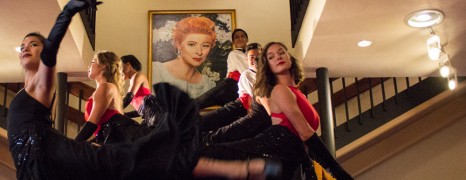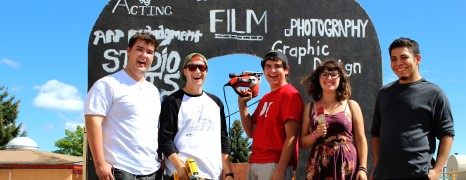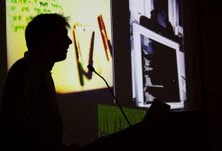College of Santa Fe and Santa Fe University of Art and Design have many luxuries, thanks to Greer Garson, whose 110th birthday was celebrated by the Performing Arts Department Sept. 26 in the Greer Garson Theatre lobby.
SFUAD Fiesta Float celebrates history of school
posted by Zoe Baillargeon
There are few greater ways to kick off a school year than with a parade. Every year in early autumn, the city of Santa Fe mobilizes around its most cherished of local traditions, Fiesta. Originally established in 1712 to celebrate the Spanish re-conquest of the city, the Fiestas de Santa Fe may have a religious overtone, involving several masses throughout the week, but perhaps most beloved are the ritualistic burning of Zozobra, Desfile de Los Ninos, or as it is affectionately known, the Pet Parade, and the Historical/Hysterical parade, a salute to Santa Fe’s past and current quirky citizens. This year, the broiling Sunday afternoon was greeted by devoted Santa Feans lining the streets of downtown, caked in sunscreen and hovering under umbrellas for protection from the fierce desert sun. Everywhere, women and young girls twirl their traditional fiesta dresses, colorful concoctions of lace and satin. Men roar “Que Viva!” while pumping their fists skyward. The air is ripe with celebration. Midway through the parade, a truck driven by Peter Romero, head of SFUAD facilities, chugs down the street, dragging behind it a trailer covered along the bottom with a flowing silver tinsel skirt, and on the wooden flats above, an eye-catching display of earthy-toned triangles. A huge black arch protrudes from the back, proudly proclaiming SFUAD. On the back of the arch, the names of the various departments are written carefully in white paint, each with a different font or symbol to celebrate the department’s specialty. People cheer as students wave from the float, throwing candy into the crowds. A few students on the sidelines cry “Que Viva SFUAD!” The float was the handiwork of senior Chelsea Kuehnel, who played a key role in deciding a theme, as well as in making the float safer for students to ride on, thanks to her background as a technical theater major. “My experience with technical theater was definitely a plus, especially having worked a lot with flats and painting,” she says Friday afternoon, having set up several volunteers with tasks before hurrying off to class. But this was not her first time being involved with the Fiesta Float. “I first did it my freshman year. I walked behind it in the parade.” The 2014 float theme centered around SFUAD’s distinctively shaped and colored logo, as demonstrated by the cuts of the flat boards, the multi-colored array of triangles, and the black arch with the department’s names. “We wanted to showcase the overall unity of the campus,” Kuehnel says. Raya Lieberman, a freshman photography major, notes that the colors used “went with the landscape of the school and Santa Fe.” But there was more inspiration behind the design than met the eye. “We tried to incorporate a little bit of College of Santa Fe into it (the float), because there is a historical component (to the parade), and in fact one of the categories for the float was historical,” says David DeVillier, the new assistant director of student life, who collaborated with Kuehnel and other student leaders and organizations, such as the SFUAD Student Ambassadors, to create the float. “We wanted to really be a part of Fiesta Parade as it was intended… there is a rich history of celebrations and festivals. So, since there’s a religious component to the parade itself, College of Santa Fe also had a religious component, with the LaSallean brothers…. so we tried to build on that, and we thought of using some icons and images relating back to the history and how we have come to this creative art school.” DeVillier also expressed gratitude to Kuehnel and the...
Alumni Profile
posted by Arianna Sullivan
“As far as the Internet is concerned,” says Cordillera Productions Executive Director Jason Jaacks, “we are dealing with a Model T. There’s no V-8 here, And two weeks ago, we were like the Flinstones.” The Internet is still young in its development, but changing quickly. As it continues to grow and evolve as the leading tool for information sharing, documentarians like Jaacks are looking for ways to adapt storytelling to the Internet. Jaacks shared these thoughts in a lecture, “Documentary Without Borders: The Future of Storytelling in the Internet Age” on campus Oct. 3. According to Alenty, an Internet rating company, the average viewing time for a single web page is 33 seconds. Jaacks, a second-year student at the Berkeley School of Journalism and a 2009 graduate of the College of Santa Fe’s documentary studies program, is exploring storytelling techniques to engage viewers with attention spans shaped by the web. In order to create narratives that can hold an Internet user’s attention, Jaacks is experimenting with telling visual stories that have multiple narrative arcs and points of entry and that are interactive for the viewer—essentially interactive online movies. Jaacks cites Hollow as an example and source of inspiration for multimedia visual documentaries. The ‘movie’ explores the stories of more than 30 residents of McDowell County, W. Va. Online, Hollow consists of several visual timelines, made up of still and moving images, which can be scrolled through at the viewer’s leisure. Along the way are links to the detailed narratives of the stories featured on the timeline. The first time that Jaacks visited Hollow’s website, he spent two hours on it, putting the 33 second average viewing time to shame. Jaacks began telling stories through several mediums with his senior thesis as a student at CSF. His...




 Jackalope Magazine is the student magazine of Santa Fe University of Art and Design. Building on the interdisciplinary nature of our education, we aim to showcase the talent of our university and character of our city.
Jackalope Magazine is the student magazine of Santa Fe University of Art and Design. Building on the interdisciplinary nature of our education, we aim to showcase the talent of our university and character of our city.
Recent Comments